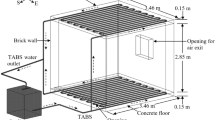Abstract
Thermal conditions in an office room with a chilled beam having integrated radiant panel (CBRP) were analysed in the full-scale laboratory test and using computational fluid dynamic (CFD) simulation. Thermal conditions in the office room were measured in six heating cases under steady state conditions that had different window surface temperatures and internal heat gain conditions. CFD simulations of two measured cases were done in order to investigate indoor climate conditions in more detail and comparing CFD results to measured results. An additional CFD simulation was done with office desk location to near to window to study thermal conditions below the desk. Ventilation efficiency was studied with CFD-simulation. Indoor climate conditions with all measured cases were at good level. Radiant asymmetry and vertical temperature stratification fulfil the requirements of category A in ISO-7730. The highest room air velocities and draught rate readings were 0.16 m/s and 17% respectively. The results indicate that radiant panel heating is applicable solution also in cold climate. Good thermal conditions could be ensured when the temperature of window surface is at least 14–15 °C. At the same time, vertical temperature stratification is acceptable and thus maintains high energy efficiency. Results indicate also that when room is occupied and ventilation is introduced, the temperature gradient is much smaller compared to unoccupied room space.
Similar content being viewed by others
References
ASHRAE (2005). ASHRAE Handbook—Fundamentals. Atlanta: American Society of Heating, Refrigerating and Air-Conditioning Engineers.
Babiak J, Olesen B W, Petrás D (2007). REHVA Guidebook No 7: Low Temperature Heating and High Temperature Cooling. Brussels: REHVA.
Bojić M, Cvetković D, Marjanović V, Blagojević M, Djordjević Z (2013). Performances of low temperature radiant heating systems. Energy and Buildings, 61: 233–238.
Cvetković D, Bojić M (2014). Optimization of thermal insulation of a house heated by using radiant panels. Energy and Buildings, 85: 329–336.
EN (2004). EN 14240:2004, Ventilation for Buildings—Chilled Ceilings—Testing and Rating. Brussels: European Committee for Standardization.
EN (2007). EN 15251:2007, Indoor Environmental Input Parameters for Design and Assessment of Energy Performance of Buildings Addressing Indoor Air Quality, Thermal Environment, Lighting and Acoustics. Brussels: European Committee for Standardization.
European Commission (2010). EPBD Recast: Directive 2010/31/EU of the European Parliament and of the Council of 19 May 2010 on the Energy Performance of Buildings (recast). Available at http://eurlex.europa.eu/LexUriServ/LexUriServ.do?uri=OJ:L:201 0:153:0013:0035:EN:PDF.
Fonseca N, Cuevas C, Lemort V (2010). Radiant ceiling systems coupled to its environment part 1: Experimental analysis. Applied Thermal Engineering, 30: 2187–2195.
Imanari T, Omori T, Bogaki K (1999). Thermal comfort and energy consumption of the radiant ceiling panel system: Comparison with the conventional all–air system. Energy and Buildings, 30: 167–175.
ISO (2005). ISO 7730:2005, Ergonomics of the Thermal Environment—Analytical Determination and Interpretation of Thermal Comfort Using Calculation of the PMV and PPD Indices and Local Thermal Comfort Criteria. Geneva: International Organization for Standardization.
Koskela H, Heikkinen J, Niemelä R, Hautalampi T (2001). Turbulence correction for thermal comfort calculation. Building and Environment, 36: 247–255.
Koskela H, Häggblom H, Kosonen R, Ruponen M (2011). Flow pattern and thermal comfort in office environment with active chilled beams. HVAC&R Research, 18: 723–736.
Koskela H, Häggblom H, Kosonen R, Ruponen M (2010). Air distribution in office environment with asymmetric workstation layout using chilled beams. Building and Environment, 45: 1923–1931.
Kurnitski J, et al. (2013). REHVA nZEB technical definition and system boundaries for nearly zero energy buildings. REHVA Technical Report 4.
Mustakallio P, Bolashikov Z, Kostov K, Melikov A, Kosonen R (2016). Thermal environment in simulated offices with convective and radiant cooling systems under cooling (summer) mode of operation. Building and Environment, 100: 82–91.
Mustakallio P, Moilanen T, Ruponen M, Kosonen R, Hagström K (2005). Development of CFD model for a cooled beam—Importance of product specific boundary conditions. In: Proceedings of 8th REHVA World Congress Clima, Lausanne, Switzerland.
Nielsen PV, Allard F, Awbi HB, Davidson L, Schälin A (2007). REHVA Guidebook No 10: Computational Fluid Dynamics in Ventilation Design., Brussels: REHVA.
Rahimi M, Sabernaeemi A (2010). Experimental study of radiation and free convection in an enclosure with a radiant ceiling heating system. Energy and Buildings, 42: 2077–2082.
Rhee K-N, Kim KW (2015). A 50 year review of basic and applied research in radiant heating and cooling systems for the built environment. Building and Environment, 91: 166–190.
Thalfeldt M, Pikas E, Kurnitski J, Voll H (2013). Façade design principles for nearly zero energy buildings in a cold climate. Energy and Buildings, 67: 309–321.
Tian Z, Ding Y, Wang S, Yin X, Wang M (2010). Influence of the ventilation system on thermal comfort of the chilled panel system in heating mode. Energy and Buildings, 42: 2360–2364.
Woollett J, Rimmer J, et al. (2015). REHVA-ASHRAE Guidebook No 21: Active and Passive Beam Application Design Guide. Atlanta: American Society of Heating, Refrigerating and Air-Conditioning Engineers.
Author information
Authors and Affiliations
Corresponding author
Rights and permissions
About this article
Cite this article
Mustakallio, P., Kosonen, R. & Korinkova, A. Full-scale test and CFD-simulation of radiant panel integrated with exposed chilled beam in heating mode. Build. Simul. 10, 75–85 (2017). https://doi.org/10.1007/s12273-016-0309-0
Received:
Revised:
Accepted:
Published:
Issue Date:
DOI: https://doi.org/10.1007/s12273-016-0309-0




